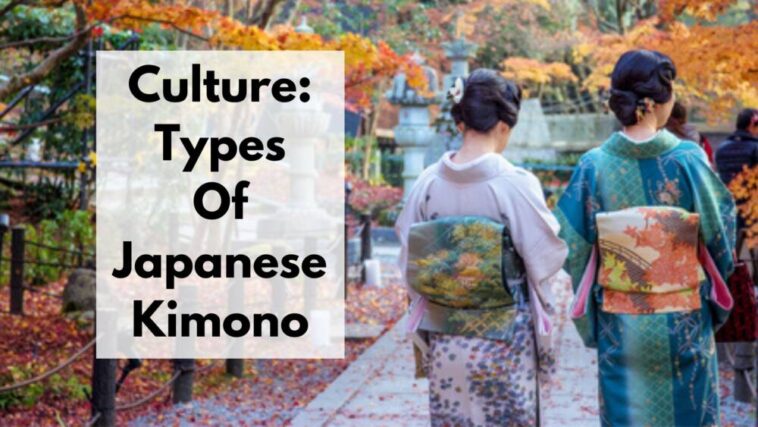Want to know about kimonos? Here are the types of kimonos and everything you need to know about Japanese kimonos and Yukatas. Check it out!
Kimono is the traditional attire of Japan and is worn by Japanese women during special occasions. These kimonos have today become exceedingly popular all across the world. Kimonos have become a fashion trend and people love getting one for themselves.
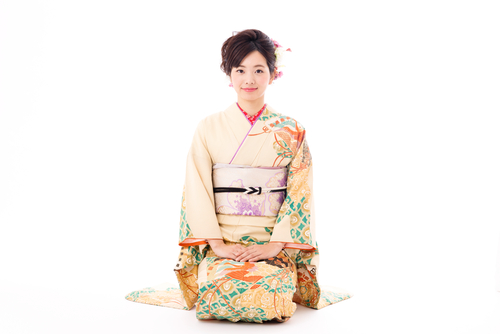
As a foreigner, I love trying on the different types of Japanese kimono. There are so many styles, patterns, and colors of Japanese kimono. You can use all the different types of these kimonos to match your different moods and seasons. Want to know about all these different types of kimono? Continue reading!
- Related: Why Japanese Wear Kimono
- Related: Where to buy Kimono in Japan
What is a Japanese Kimono?

Kimono is a traditional Japanese attire that is worn on different occasions. Just like every culture follows a particular dress code, Japan also does the same. There are different types of kimonos that are worn on various different occasions. It is a cloth that is wrapped around the body and knotted on the left side with some accessories over it. Also, both married and unmarried women wear kimonos but of different types.
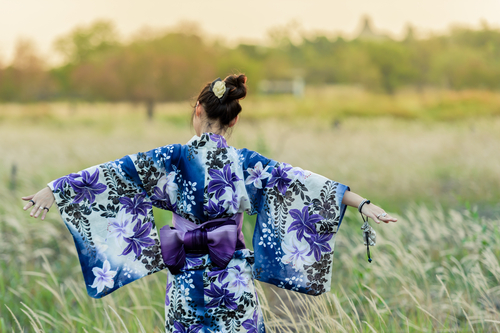
Page Contents
Types of Kimono
Furisode
The first type of kimono falls in the category of formal wear depending upon how long and short the sleeves are. Furisode kimono is worn by young and unmarried women. There are three different types of Furisode kimonos that are differentiated on the basis of their sleeves, that is short, medium, and long; these are named Kofurisode, chu-furisode, and Ofurisode, respectively.
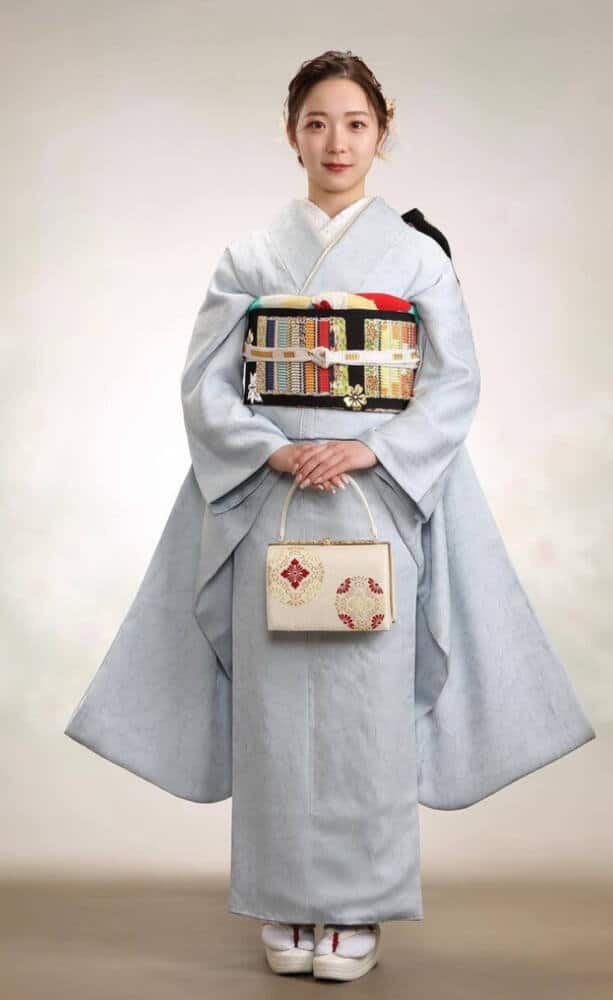
From these, Ofurisode is the most formal one with paddings attached to it and is mostly worn on special occasions like weddings or any other function. The padding in this type of kimono adds some weight to it. It also adds durability to the kimono.
Chu-furisode, on the other hand, is light and comes without any padding. It has some eye-catching prints on it. It has become a very popular option amongst young women. This is a go-to option for many during the hot summer months because it is lighter and cooler than the other types.
Lastly, Kofurisode is the one that can be paired with hakama pants or formal pants and has the shortest sleeves. It is also not as common as other Furisode kimono types. This type was extremely popular amongst Japanese school girls during the Meiji period.
Hikizuri
Hikizuri is another type of kimono that is known to be worn by wealthy women. The meaning of Hikizuri is ‘trailing skirt’ which means that this kimono has a long cloth attached to it.
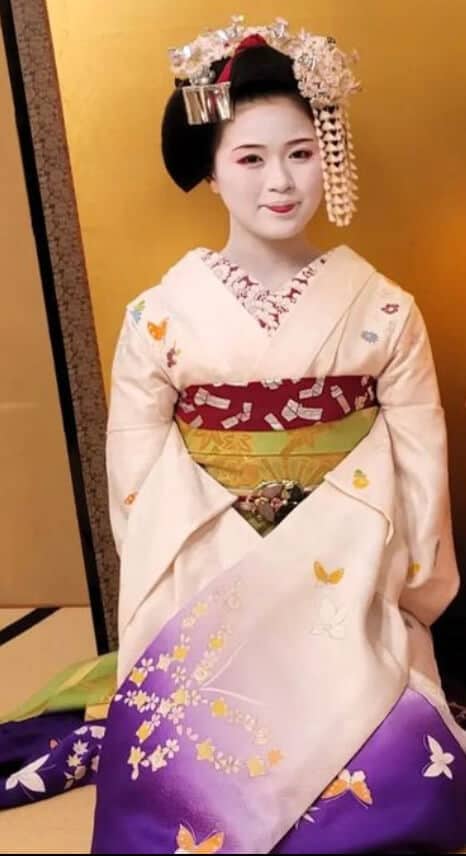
Currently, this kimono is worn by stage performers and dancers. Now, women tie this cloth around their waist when they move out while wearing this kimono. When I went to Japan, I tried this one and felt absolutely beautiful in this lovely dress. It really brought out this whole new feminine side that made me feel gorgeous and confident.
Tomesode
I wore a colorful Tomesode kimono when I visited Japan, mainly because I wanted to try all different types at least once in my life. My recent trip to Japan helped me fulfill this wish to a great extent.
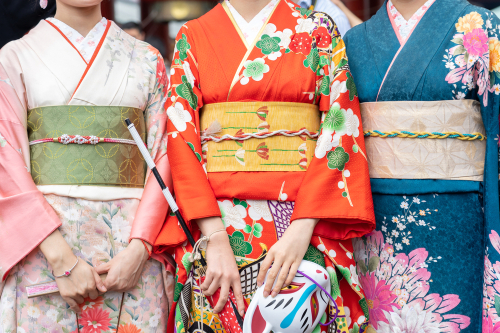
There is a reason behind wearing a colorful one. Tomesode kimono are the most formal ones with 1 to 5 crests and silver or golden work on them. There are two types: black, which is only worn by married women and which has golden and silver work; colorful, which is basically a kimono in different colors and prints and is worn by unmarried girls.
If you have a tea party or a marriage party to attend in Japan, do give this kimono a try. This kimono will surely help you get involved in the beauty of Japanese culture.
Houmongi
Here is another kimono dress that is known as Houmongi, which means a visiting dress. Basically, you can wear this dress when you have to visit a friend or attend an informal gathering.
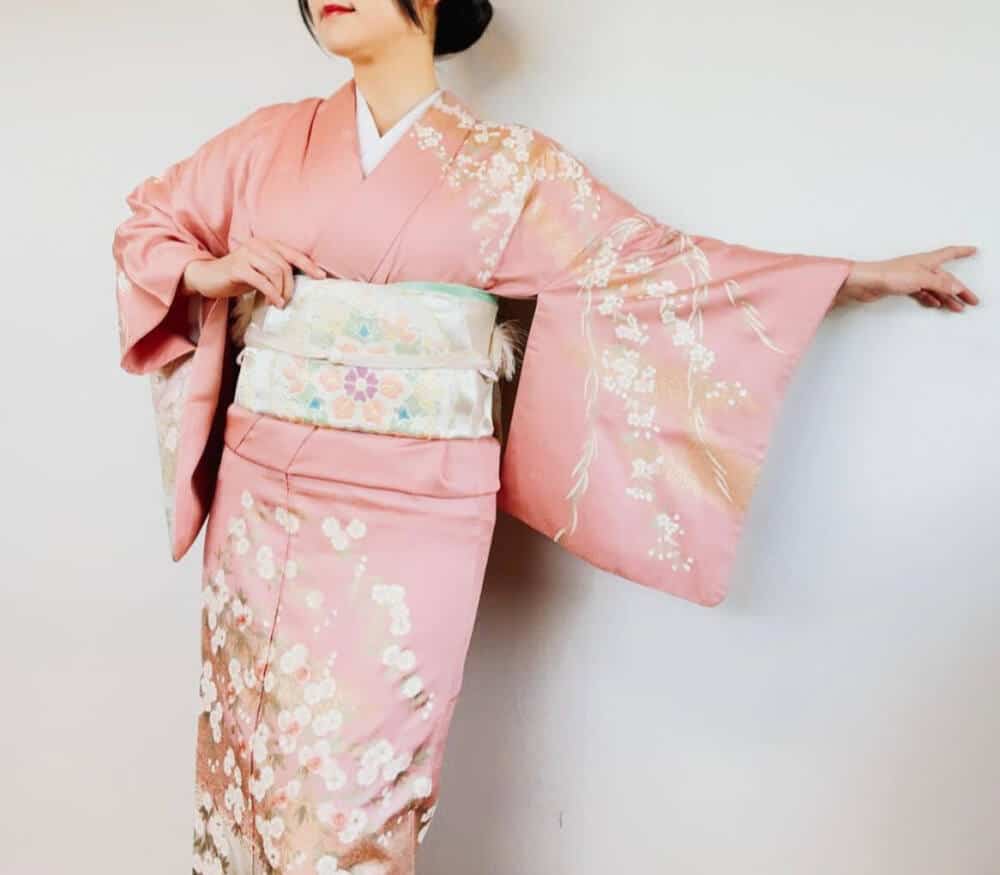
This dress is not very formal as compared to the most formal one ‘Tomesode’. Semi-formal in nature, these have a pattern going around the sleeves and hemline which looks elegant and beautiful.
Iro Muji
This kimono is extremely simple and sophisticated as it has no patterns or prints. The simplicity of this kimono speaks for it. In this category only, you can also find a particular simple kimono for tea parties or casual occasions.
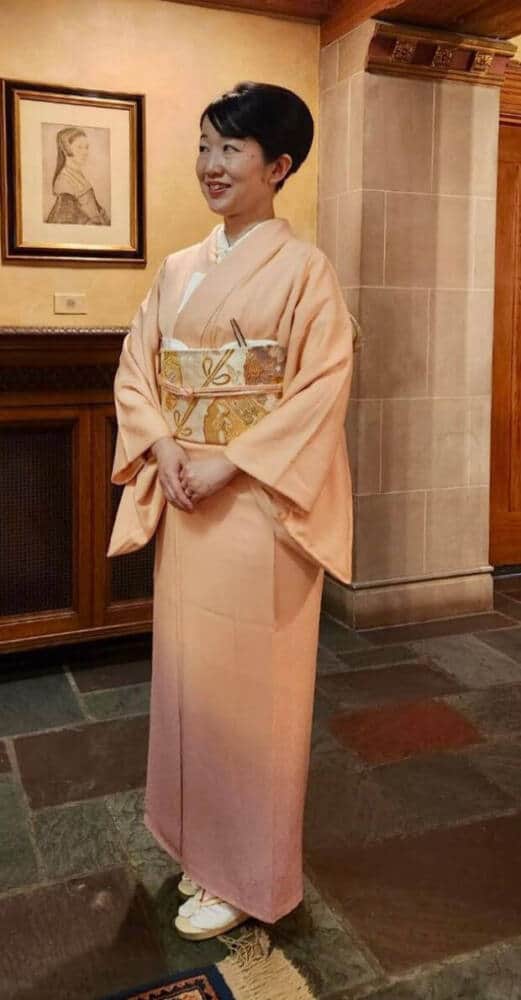
Talking about them being formal or non-formal, it entirely depends on the number of crests the kimono has. Also, they can be worn by both married and unmarried women. I have got one for myself as well and it is always admired by people. I make sure I wear it to certain gatherings, simply because it has an air of beauty and grace in it.
Komon
Earlier, when western clothes were not really hyped in Japan, people used to wear Komon. Komon is the most common and informal kimono type of all and is suitable for daily wear and small occasions.
It is not appropriate to wear them at big events. Talking about the pattern, they are simple and have vertical lines or print, and are available in multiple colors. I love to know deeply about other cultures and food and clothing are two of the best ways.
While I was staying back in Japan, I had myself a few pairs to get a real feeling there. And believe me, Komon was all I wore for most of my stay in Japan. It is absolutely comfortable and it also helps you blend in with the locals.
Yukata
In summers, everybody prefers clothes that are light and cool. Similarly, this Japanese kimono comes in the category of comfortable summer wear dress. Yukata dress is worn at summer festivals or on a hot day out.
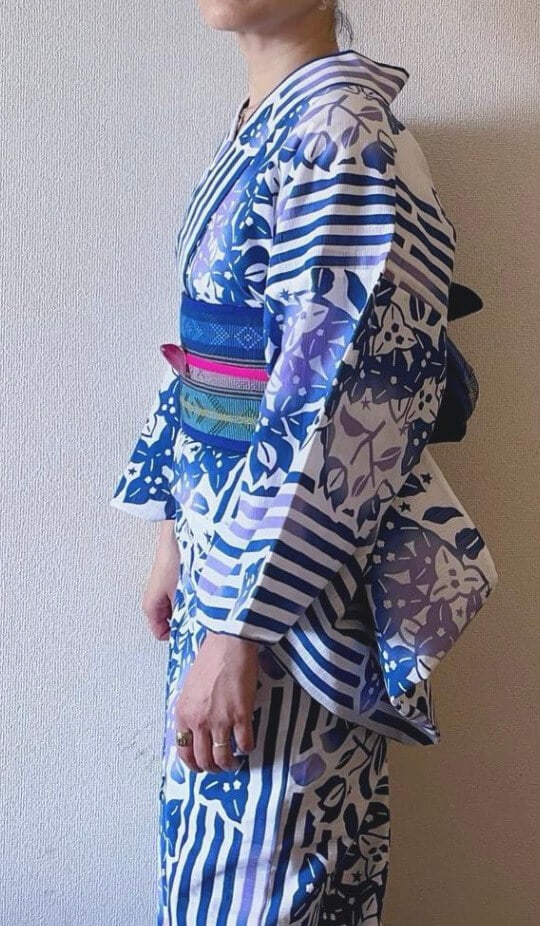
They are not fancy-looking kimonos but are very simple and subtle with beautiful prints and colors. Being the most informal of all, this is also the very famous type as it is more comfortable. When I was in Japan, I was lucky enough to enjoy one of the summer festivals called cosplay and I wore this beautiful garment there to feel the vibe from my heart.
Shiromuki
Shiromuki, a wedding kimono, is a white dress in the form of kimono that is worn by brides to look special and different. Every culture has its own meaning for a particular color and in the same way, the Japanese white kimono also has a special meaning for being white.
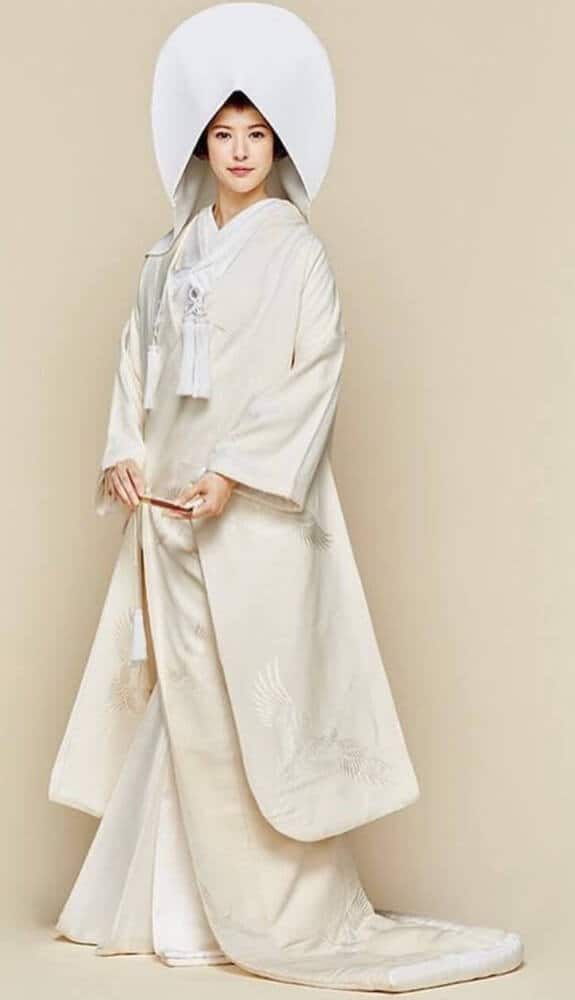
White is the symbol of accepting the new family and blending into it while accepting them by heart and that is what this dress signifies. Other than that, it looks beautiful and even enhances the beauty of the bride in the most perfect way. I saw my Japanese colleague wearing it on her special day and she truly looked fabulous while staying true to her roots.
Mofuku
Many cultures prefer white or black for sad events to keep the environment away from any disturbance. In Japanese culture, it is the color black that is worn on a mourning day. This kimono type, known as Mofuku, is a black silk fabric dress that is worn by both men and women.
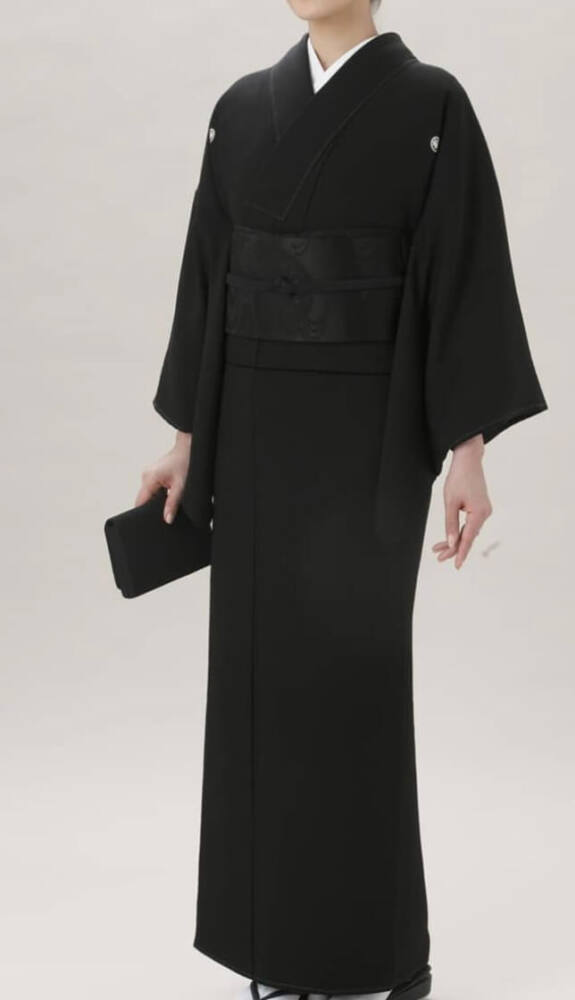
Also, it is worn over white undergarments and also has five crests on it. In Japan, black is the color of death so if you plan to visit Japan, do not pack black clothes unless you are specifically going for such an event.
Katamigawari
In the wide category and range of kimonos, this type is completely different from all other formal and casual kimonos. It is different because of its patterns, colors, and designs.
To be precise, these are worn by stage performers and dancers and have double-sided patterns, which means having a different color and print on the left and right sides.
The name ‘Katamigawari’ itself means half and half. The fabric of these kimonos is different from the ones worn by others and it needs to be washed regularly. While attending an event in Japan, I had noticed the performers dancing beautifully wearing these beautiful kimonos. It was an eye-catchy moment as the dress represented the culture brilliantly.
Wedding Kimono Or Uchikake
The wedding kimono, known as “uchikake” or “shiromuku,” holds a revered place in Japanese culture, symbolizing beauty, tradition, and the sacred union of two souls. These exquisite garments are meticulously crafted with meticulous attention to detail, showcasing intricate designs, vibrant colors, and luxurious fabrics.
The wedding kimono is a visual masterpiece, often featuring embroidered motifs, floral patterns, and motifs inspired by nature. The choice of colors holds significant meaning, with shades of red symbolizing good fortune and happiness, while white represents purity and new beginnings. Gold accents are often incorporated, adding a touch of opulence and prosperity to the ensemble.
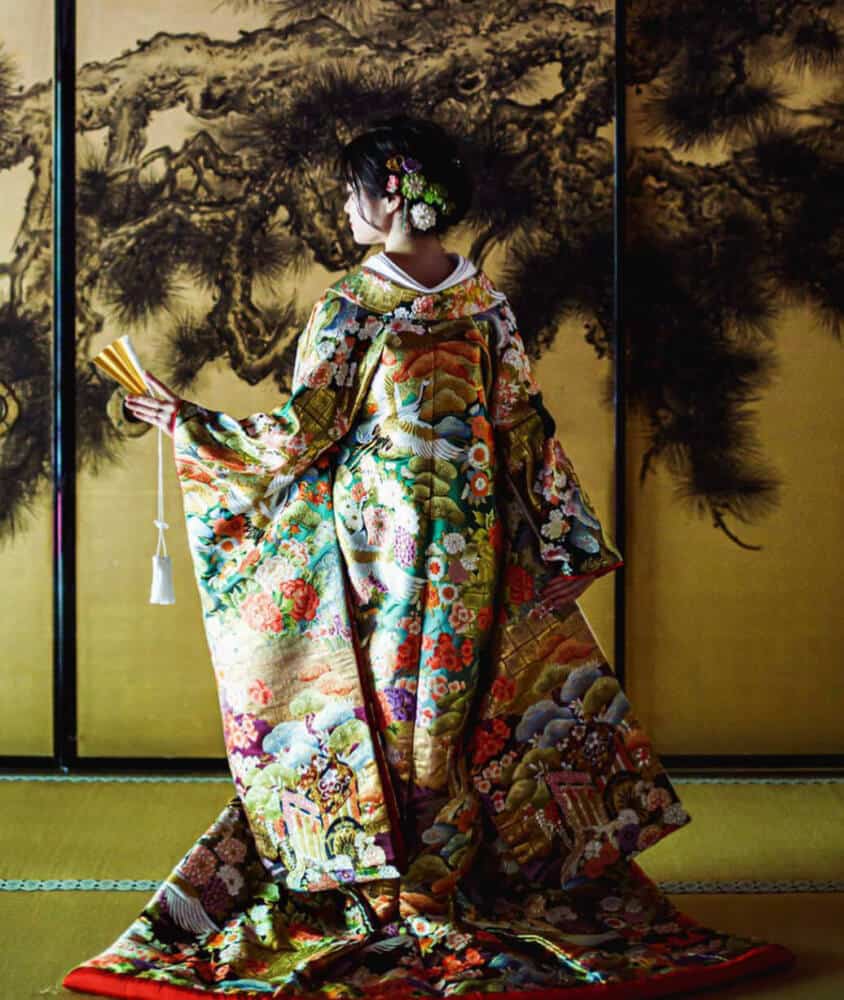
Every element of the wedding kimono carries cultural and symbolic significance. The layers of silk and the voluminous sleeves create an aura of grace and elegance, while the obi (sash) intricately tied around the waist serves as a focal point, accentuating the waistline and completing the ensemble.
These timeless garments are not only a feast for the eyes but also a reflection of Japanese traditions and customs. Passed down through generations, the wedding kimono carries with it the stories and blessings of countless couples who have embarked on their matrimonial journey.
Today, the wedding kimono continues to enchant and captivate both Japanese couples seeking to honor their heritage and individuals around the world drawn to its unparalleled beauty. Whether worn during the ceremony or preserved as a cherished heirloom, the wedding kimono evokes a sense of reverence and serves as a tangible link to the rich cultural tapestry of Japan.
As modern weddings embrace diversity and fusion, the wedding kimono transcends cultural boundaries, becoming a statement of individuality and a celebration of the unique love shared between two individuals. Its allure lies in the fusion of tradition and contemporary style, blending the old with the new to create a one-of-a-kind bridal ensemble that embodies grace, elegance, and a profound connection to the past.
The wedding kimono is not merely a garment but a vessel of emotions, dreams, and the promise of a lifetime of love and happiness. Its timeless elegance and enduring beauty make it a treasured symbol of a joyous union, encapsulating the essence of an unforgettable moment shared by two souls embarking on their journey of togetherness.
Kurotomesode
In the realm of traditional Japanese attire, the kurotomesode stands as a pinnacle of refined beauty and grace. This exquisite kimono holds a special place in formal occasions and represents an ensemble of utmost elegance and sophistication.
The kurotomesode is distinguished by its rich black silk fabric, which serves as a canvas for intricate and intricate designs. Adorned with exquisite patterns, the garment embodies a harmonious fusion of artistry and tradition. These patterns, known as “mon,” typically consist of family crests, auspicious motifs, or symbolic elements that convey meaning and heritage.
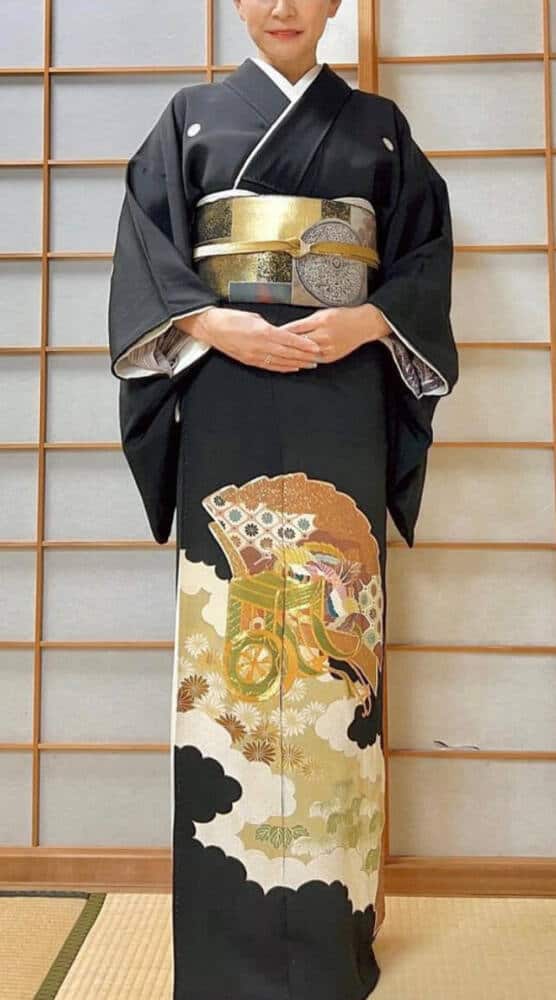
Traditionally worn by married women, the kurotomesode is a symbol of maturity and social status. Its graceful silhouette and floor-length hem create an aura of poise and grace, enhancing the wearer’s presence during formal events such as weddings, receptions, and important ceremonies.
The kurotomesode is often paired with accessories like an obi (sash) and a beautiful obijime (cord), further accentuating the elegance of the ensemble. The meticulous craftsmanship, attention to detail, and luxurious fabrics used in its creation make it a timeless masterpiece, treasured for generations.
While black may be its defining color, the kurotomesode showcases a kaleidoscope of hues through its intricate designs. Splashes of vibrant colors, delicate embroidery, and metallic accents add depth and visual allure to the ensemble, creating a captivating harmony that captures the essence of Japanese aesthetics.
Today, the kurotomesode transcends cultural boundaries, captivating individuals worldwide with its timeless appeal. It serves as a symbol of tradition, refinement, and the enduring beauty of Japanese culture. Whether worn to honor heritage or as a statement of elegance, the kurotomesode encapsulates the essence of an exquisite attire that has stood the test of time.
The kurotomesode is more than a garment; it is a testament to the artistry, heritage, and exquisite craftsmanship that define Japanese fashion. Wearing the kurotomesode bestows a sense of pride and sophistication, allowing one to step into a world of tradition and grace. It embodies the culmination of beauty and tradition, making it a truly cherished and remarkable piece of attire.
Natsu no Kimono
Natsu no Kimono, also known as “summer kimono” or “ro kimono,” is a lightweight and breathable garment crafted to provide comfort in hot and humid weather. These kimono are typically made from lightweight fabrics like cotton or silk gauze, allowing air circulation and aiding in moisture absorption.
The design of Natsu no Kimono often features open weaves, loose sleeves, and shorter lengths to facilitate better airflow and enhance the wearer’s comfort. They may also incorporate seasonal motifs such as summer flowers, fireworks, or ocean waves to capture the essence of the season.
Natsu no Kimono are available in various vibrant colors and patterns, offering a refreshing and lively look during the summer months. They are often paired with a wide obi (sash) that adds a touch of elegance while allowing for a breezier feel. To complete the ensemble, lightweight accessories like straw sandals (zori) and a wide-brimmed hat (kasa) are commonly worn.
Usumono:
Usumono refers to lightweight kimono specifically designed for the hottest days of summer. The term “usumono” translates to “thin garment” or “light kimono.” These kimono are made from sheer and delicate fabrics like silk gauze or transparent silk, which provide maximum breathability and a cooling effect.
Usumono are characterized by their airy and translucent nature, allowing the skin to breathe and offering relief from the sweltering summer heat. The patterns and colors of usumono tend to be more subdued, often featuring pastel hues or subtle designs that evoke a sense of coolness and tranquility.
To complement the lightness of usumono, minimalistic accessories such as thin obi (sashes) and simple sandals are often chosen. The focus is on maintaining a comfortable and relaxed attire that embraces the essence of summer.
Both Natsu no Kimono and Usumono serve as elegant solutions to beat the summer heat while retaining the timeless beauty and grace of traditional Japanese fashion. These garments are not only practical but also showcase the artistry and adaptability of kimono to different seasons, allowing wearers to experience the comfort and aesthetic pleasures unique to each time of the year.
Odori Isho
Odori Isho, also known as “dance attire” or “dance costume,” refers to a specialized type of kimono worn by dancers in traditional Japanese dance performances. The term “odori” means “dance,” while “isho” translates to “attire” or “costume.”
Odori Isho is designed to accentuate the graceful movements and artistic expression of the dancer while adhering to the aesthetics and traditions of Japanese dance. These costumes are meticulously crafted, often featuring vibrant colors, intricate patterns, and elaborate embroidery to enhance the visual impact of the performance.
The design of Odori Isho varies depending on the style of dance and the specific dance repertoire being performed. Some common elements found in these costumes include:
- Furisode-style Sleeves: Odori Isho often feature long, flowing sleeves known as “furisode.” These sleeves add elegance and fluidity to the dancer’s movements, creating a captivating visual effect.
- Obi (Sash): The obi worn with Odori Isho is typically wide and intricately tied in a decorative manner. The obi serves to cinch the kimono at the waist and adds a touch of sophistication to the overall ensemble.
- Intricate Patterns and Motifs: Odori Isho showcases elaborate patterns and motifs that reflect the theme or story of the dance. These designs are often inspired by nature, historical tales, or traditional symbols, and they are meticulously created using techniques like embroidery, dyeing, or painting.
- Accessories: Various accessories are incorporated to complement the Odori Isho, such as decorative hairpins, fans, and sometimes small bells that jingle with the dancer’s movements, adding an auditory element to the performance.
The choice of fabric for Odori Isho can vary, ranging from silk to synthetic materials, depending on factors such as the dance style, budget, and practicality of the performance.
Odori Isho represents not only the artistry of dance but also the cultural heritage and traditions of Japan. These costumes play a significant role in conveying the narrative and emotions of the dance performance, creating a visual spectacle that captivates audiences and preserves the essence of traditional Japanese dance.
It’s worth noting that Odori Isho is distinct from everyday kimono or formal kimono styles, as it is specifically tailored to meet the unique requirements and aesthetic demands of dance performances.
Junihitoe
Junihitoe, also known as “twelve-layered ceremonial kimono,” is a highly complex and ornate traditional garment worn by noblewomen in Japan. The term “junihitoe” translates to “twelve-layer robe” in English, referring to the numerous layers of fabric that make up the ensemble.
Historically, junihitoe was primarily worn by members of the imperial court and aristocracy during important ceremonial occasions, such as weddings, coronations, or other significant events. It symbolized the high social status and refined taste of the wearer.
The construction of junihitoe involves layering twelve different robes on top of each other, each with a distinct color and pattern. The layers include undergarments, robes, and outer robes, meticulously arranged to create a stunning visual effect. The colors and combinations of the layers hold symbolic meaning, representing specific seasons or auspicious motifs.
The outermost layer of junihitoe is typically made from a luxurious silk brocade fabric, featuring intricate designs and embroidery. The patterns often depict scenes from nature, such as flowers, birds, or landscapes, emphasizing the connection between the wearer and the beauty of the natural world.
To complement the ensemble, various accessories are worn with junihitoe, including a decorative headdress called “kanzashi,” an obi (sash) tied in an elaborate manner, and an assortment of jewelry such as hairpins, necklaces, and earrings.
Due to the complexity and weight of the junihitoe, wearing it requires assistance and meticulous attention to detail. The layers must be draped precisely and secured with intricate folding techniques to ensure a graceful appearance.
In modern times, junihitoe is rarely worn, as it is reserved for highly formal and ceremonial occasions within the imperial court or as a part of historical reenactments. The craftsmanship and cultural significance associated with junihitoe make it a cherished symbol of Japan’s rich history and traditions.
The junihitoe serves as a testament to the artistry and craftsmanship involved in creating such intricate garments. Its exquisite beauty and complex layers evoke a sense of regality, capturing the essence of traditional Japanese culture and the reverence for ceremonial attire.
Men’s Kimono
Yes, the men in Japan also wear kimono, although it is not as common or popular as the women’s kimono. There was a time in Japan when men used to wear kimono every day. While women’s kimonos are vibrant and colorful with beautiful artwork, the kimonos worn by men are more subdued.
The formal men’s kimono type is a simple yet sophisticated combination of kimono pants and kimono jackets, known as Hakama and Haori respectively.
Kinagashi is also a very common kimono style for men. It is simply worn with an obi belt that is tied around the waist.
Types of Kimono: FAQs
What is the most formal type of kimono?
The most formal type of kimono in Japanese culture is the “furisode.” It is characterized by long, flowing sleeves and vibrant patterns. Worn by young, unmarried women for important ceremonies, the furisode symbolizes elegance and femininity. With its intricate designs and bold colors, it is typically worn for events like weddings and tea ceremonies. The furisode is considered the pinnacle of formality in kimono attire, showcasing the artistry and cultural heritage of Japan.
What is a yukata vs kimono?
A yukata and a kimono are traditional Japanese garments. The yukata is made from lightweight materials and is worn during summer events, while the kimono is made from heavier fabrics and is worn on formal occasions.
What is a half kimono called?
A half kimono is commonly referred to as a “haori.” The haori is a versatile and stylish garment that serves as a jacket or outerwear piece to be worn over a kimono or other attire. It is shorter in length compared to a full-length kimono, typically reaching to the waist or hip area. The haori features wide and loose sleeves, providing ease of movement and a relaxed fit. It is designed to be worn open in the front, allowing glimpses of the underlying kimono or clothing. The haori is often adorned with exquisite patterns, intricate embroidery, or decorative motifs, showcasing the artistic craftsmanship that is synonymous with Japanese fashion.
What is a Kosode kimono?
A kosode is a type of kimono characterized by its simple and unlined structure. The term “kosode” translates to “small sleeves” in Japanese, referring to the garment’s relatively narrow and shorter sleeves compared to other kimono styles. Originally worn as an undergarment during the Heian period (794-1185), the kosode evolved over time to become a popular outerwear garment. It is characterized by its straight-cut construction, absence of a collar stand, and versatile design. Kosode kimono are often adorned with intricate patterns, delicate embroidery, or hand-painted motifs, showcasing the artistry and elegance of traditional Japanese clothing.
What are casual kimonos called?
Casual kimonos are commonly referred to as “komon” or “komonosuki.” These kimonos are characterized by their all-over repeating patterns, which can range from small and intricate motifs to larger and bolder designs. Unlike formal kimonos that feature more elaborate patterns or family crests, komon kimonos have a more relaxed and everyday appeal. They are often made from lightweight fabrics such as silk or cotton and are suitable for casual occasions, outings, or informal gatherings. Komon kimonos offer a comfortable and stylish option for individuals who wish to embrace traditional Japanese fashion in a more relaxed and approachable manner.
Can you wear a kimono if you’re not Japanese?
Absolutely! Wearing a kimono is not limited to individuals of Japanese descent. Kimonos have become popular worldwide as a fashion statement, cultural appreciation, or for special occasions. Many people, regardless of their cultural background, choose to embrace the beauty and elegance of kimono attire. It is important, however, to be respectful and mindful of the cultural significance and traditions associated with wearing a kimono. Learning about proper dressing techniques, understanding the meanings behind different patterns and styles, and seeking guidance when needed can ensure that the kimono is worn with appreciation and respect for Japanese culture.
Why does a kimono dress has a long sleeves?
The long sleeves of a kimono serve both functional and aesthetic purposes. They provide freedom of movement, allow for graceful gestures, and enhance the overall elegance of the garment.
What is the black kimono called?
The black kimono is called “kurotomesode.” Kurotomesode is a formal style of kimono worn by married women during special occasions such as weddings, ceremonies, or formal events. It is characterized by its black base color and features elegantly placed patterns, typically consisting of auspicious motifs, family crests (kamon), or nature-inspired designs. Kurotomesode is considered one of the most formal and sophisticated kimono styles, often paired with elaborate accessories and worn by women as a symbol of their marital status and refined fashion sense.
The beauty of the Japanese kimono
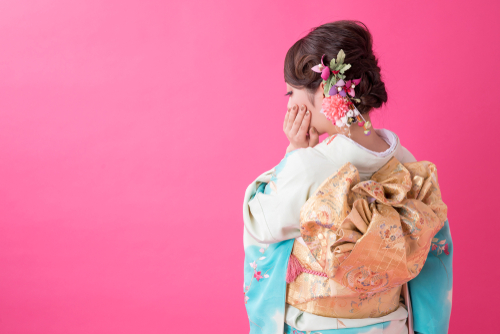
Japanese kimonos have come a long way, with various types and a change of rules. Today, the rules for wearing kimonos are not as strict as they used to be. It is probably because of this that we see the younger generation making use of modern fabrics and vibrant colors to make their kimonos.
These are then paired with unconventional accessories. I hope this guide helped you understand the kimono culture of Japan a little more. Now that you have all this knowledge, why not try one on for yourself? There is no better way to experience Japanese culture better.
Also Read:


